Yesterday And Today
Dave Humphries & Jim Hinton: Dialogue from Across the Pond
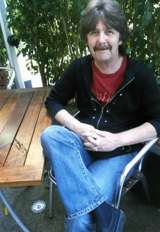
Dave Humphries
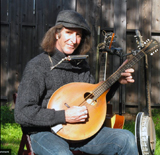
Jim Hinton
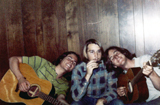
Jim Hinton (far right) & Everyman in 1971
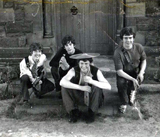
Dave Humphries (left) and the Lads, 1967
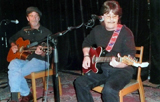
Jim Hinton & Dave Humphries at the Roots Festival this year
Over the course of the recent spring months, local musicians Dave Humphries and Jim Hinton have been hitting the coffee house circuit, swapping songs and exchanging witty banter between the tunes.
The dialogue extended beyond the parameters of a small stage, moving on to living rooms, backyard gardens, and anywhere libations were being served. What has emerged from these marathon chats is that while both men are the same age (they’re well-entrenched in the baby boomer ranks), their adolescent experiences and recollections of the ’60s provide interesting contrasts. These differences are due to Humphries having been raised in the northeastern British city of Durham, while Hinton has spent most of his life in San Diego. The following interview was conducted on May 21 and provided a welcome diversion from the audio-visual drivel dominating American media on that day.
San Diego Troubadour: Dave, would you give us your impressions of life in Britain in the ’50s?
Dave Humphries: It was like I said to Jim earlier; it felt as if it was in black and white. Everything just seemed gray. There were shortages of this, that, and the other thing. And I think that even then, there was still rationing going on. Not that I would have been really aware of that, but I found out afterward that we didn’t have very much when we were growing up. There were other kids I knew who would get new bikes. The first bike I got was somebody else’s bike. My dad took it to work and painted it and fixed it up. But it was a new bike to me and it was great! But I would see other kids who had lots more than I had. One of the observations I had when I was small was looking at the kids who were older…they all just seemed to look like what the dad looked like. They were the same suits, ill-fitting clothes.
SDT: So there was an element of conformity out there….
Dave: Yeah, without a doubt! Yes. And war time stuff? My granddad had been in World War I and he been downwind to some of the mustard gas. So he wasn’t fit enough to fight in World War II. He used to be an air raid warning person; he’d go around telling people to make sure the curtains were shut so German bombers couldn’t attack.
SDT: Pete Townshend said his parents were so traumatized by World War II that they wouldn’t talk about it. They told him to talk to his grandfather.
Dave: People didn’t talk about the war; it was like what Pete Townshend had said. But I did ask my grandfather, and the only information that I got was that kids were crying for their mothers in the trenches. But of course, he was talking about World War I.
SDT: Jim, did your family come West because of the aerospace boom? I
understand you were born in Tucson.
Jim Hinton: My dad went to college at the University of Arizona in Tucson and majored in engineering. This is during the Korean War. He joined the air force. He actually went to Ohio first. We were at Wright Patterson Air Force Base in Dayton, Ohio until 1955. Then he got out of the air force and got a job with CONVAIR in San Diego. We moved into Mission Beach at a place right on Ocean Front Walk.
SDT: I would imagine life in California at that time was pretty idyllic.
Jim: I have memories of the world being very, very clear, very big, being near the ocean.
Dave: You had everything…..
Jim: Well, you know what? We were doing okay. Dave, you were talking about the bicycles. My parents were very young when they had me. So, when I was with kids my own age, they had older parents who were a little bit better established. I had the same kind of feeling — I always loved the stuff I got at Christmas or my birthday. Just thinking about San Diego back in those days…I remember clear skies with jets streaking across the skies from North Island base in Coronado. It was very fresh, very bright blue. That was my childhood impression of San Diego, before there were freeways in Mission Valley.
Dave: It was much smaller.
Jim: Oh, it was much smaller! Highway 80 — as it was called then — was just a highway, it wasn’t a freeway. It went through Mission Valley, and instead of shopping malls there were dairy farms. I remember there was very much a navy “feel” about San Diego, and all my friends’ dads had been in the navy. My dad had been in the air force, so I was a little bit out of it [laughs]. It was a very positive, optimistic time. Everybody seemed to be in swimming pools and having barbecues. Dave was saying the ’50s was in black and white; I remember the ’50s being in vivid Technicolor.
SDT: Dave, what was the first song you remember?
Dave: It was probably one of the Bing Crosby songs that my dad used to play on his record player because we didn’t get a television until quite a few years later. Lots of Bing Crosby and another guy called Michael Holliday who was English — from Liverpool, actually. Michael Holliday was a Bing Crosby impersonator, really, but my dad liked him, too. He liked Burl Ives as well. But I think one the earliest of those tunes I loved was “True Love.” [He sings] “You give to me, and I give to you…” Bing Crosby did it as a duet with Grace Kelly in [the movie] High Society. Other Tunes? “Freight Train.” [Sings] “Freight Train, Freight Train, going so fast…” The version [I heard] was by Nancy Whiskey and Charles McDevitt. Just that bit — ”Please don’t tell which train I’m on” — just got to me. That song, and little bits of the Lonnie Donegan skiffle stuff. There were parts of that I was aware of [the British skiffle movement] but then, when you heard Elvis…
SDT: There was this tremendous explosion.
Dave: Well, of course! But the earliest stuff had to be Bing Crosby.
SDT: Jim, what’s your earliest memory of a song?
Jim: Being born in Tucson, I think the only music available was country western at the time. The first memory of a particular song was in Dayton, Ohio at the air force base. I was about four years old, and there used to be a show on TV. I remember the title — it was called The Midwestern Hayride — and it was a show where they used to have country and western singers on. There were a number of people on…there was just something magic about a cowboy and a guitar. And I put that act together when I was four. I had a cowboy hat and a guitar. It was a toy guitar, but I learned the song “Yellow Rose of Texas.” When my parents would have a party, they’d bring me down and I’d strum on this toy guitar and sing “Yellow Rose of Texas.” After that, I’d start listening to radio. There was all kinds of music, Julie London singing “Cry Me a River.” I was always enchanted by the radio, whatever came on.
SDT: That’s fortuitous, because I want to talk about radio. I guess in your childhood, Dave, radio in England was a take-it-or-leave-it proposition.
Dave: Of course, when you grew up, you didn’t know what was happening over there [the U.S.] at the time. You just knew America was “over there” and they helped us win the war against the Germans. Radio stations? We had the BBC, American Armed Forces Network, and Radio Luxembourg. The BBC had the BBC Light Programme, and they weren’t allowed to play constant records. They had a show called “Needle Time.” It meant that they could just only play so many minutes of recorded music. The rest would have to be played live or they had people chattin’ on about stuff. That’s why you have so many Live at the BBC [sessions] stuff coming out, where you have the Beatles and the Kinks and the Hollies and the Who. They had to go on the show and perform live, because they [the BBC] couldn’t play the records [hour by hour]. You could sometimes get the American Forces Network, but you had to have a different radio, or Radio Luxembourg, which was based in Europe. But it used to fade in and out so much that sometimes it was very hard to listen to. You know, you’d think, “Here comes my favorite one coming on!” You’d be under the bed sheets with the little transistor. And it would come on and just fade away, and it might come back in the middle eighth and then fade away again and it’s gone! Then another record would come on, and it’s not the one you wanted to hear. That went on to 1965 or ’66. In ’65, I remember when the pirate radio stations were coming in. Twenty-four hours of pop music a day. It was great!
When you were starting to buy the music papers — the NME [New Musical Express] and the Melody Maker — you were starting to find out how much music people were getting to hear in the U.S. They had hundreds of radio stations and we had [very few] until the pirates. Even then, it will still difficult to hear [pirate station] Radio London. We couldn’t pick that up where we were in the Northeast. But we had Radio Caroline, which was a godsend. I can still remember listening to “Ticket to Ride,” and I had the transistor just positioned right for the window for that to come in. And it was just…wow.
SDT: What impact did radio have on you, Jim?
Jim: My mom was — and is — a big music fan. So when I was a kid, the radio was on a lot. Here in San Diego, I remember we’d go back and forth between KCBQ and KGB. KCBQ was Top 40 and the DJs were [people] like Happy Hare. He was Harry Martin, and he was the legendary DJ here in town. In fact, there was a guy who lived up the street from us in La Mesa who was “KCBQuack (or Casey B. Quack).”
SDT: Was that a DJ named Jerry Walker?
Jim: Jerry Walker, right! Which wasn’t really his name…his real name was Harry Birrell. We used to have pool parties up at his house. So, we used to listen to that [station] a lot, especially during the day I remember hearing Buddy Holly doing “That’ll be the Day” and Ricky Nelson’s “Poor Little Fool.” There were all kinds of things I really liked. But remember, rock ‘n’ roll was a little bit morally suspect. I remember Dad came home from work one time and KCBQ was on. He said, “What is this? It sounds like rock ‘n’ roll!” And my mom goes; “For God’s sake, Forrest, it’s Frankie Laine!” And my dad [laughs] loved Frankie Laine. We’d also listen to KFSD [which later became KOGO-AM]. They played easy listening music. There was a definite dichotomy between your Top 40 and your easy listening station. So it was there where you heard your Tony Bennett, Frank Sinatra, Nat King Cole. I think it’s also worth mentioning that the Top 40 radio of the day also included all that. But that’s what I miss so much now.
Dave: The charts at that time were so diverse.
Jim: When the Beatles hit here in 1964, at the same time in the Top 40 you had the Ray Conniff Singers, you had Louis Armstrong with “Hello Dolly,” and you had Dean Martin with “Everybody Loves Somebody.
SDT: That was Dean Martin’s biggest hit. It knocked the Beatles out of the number one spot.
Jim: But as time went on, I got more into rock and pop. We had three great AM radio stations: KCBQ, KGB, and KDEO, which [KDEO] was in our Fletcher Hills stomping grounds. We could actually go and hang out in front of the studio and request songs. So, with three rock ‘n’ roll stations, you could have your transistor radio under the covers. You could switch back and forth [between the stations].
SDT: In addition to these radio stations, you also had XERB. They had this tremendous transmitter down in Rosarito Beach. The disc jockeys were getting requests from Alaska on clear summer nights. It was where I heard Wolfman Jack the first time. He played real black music — B.B. King, James Brown, Bobby “Blue” Bland. There was a certain mystique to him. This was the closest thing, artistically speaking, to a British pirate radio station. Wolfman would sell everything from religious figures for your dashboard to weight-reduction pills. And, of course, he had his oldies records to sell. He had this big studio echo, which made listening to him an experience from another world.
Jim: We listened to XERB to hear Wolfman Jack!
Dave: But you didn’t have [Peter Sellers’ radio comedy troupe] the Goons!
Jim: We did not have the Goons [laughs], we didn’t! KFI was a 50,000-watt station out of L.A. I first turned on KFI to hear Dodger games with Vince Scully and Jerry Doggett. They had a disc jockey named Dick Sinclair, and he would play old time music from the ’20s and ’30s. This was dream time; the older the recording, the more I was intrigued by it. This was kind of (San Diego Troubadour columnist) Lou Curtiss territory, going back into those types of things and hearing “My Blue Heaven.” That for me was like a real musical wonderland.
SDT: And then, when the Beatles broke through, there was a hotly contested battle among the three AM stations in San Diego on who would be playing the most Beatles songs in an hour. KDEO had a commercial that went something like this: KGB played five Beatles songs in an hour, KCBQ played 12 Beatles songs in an hour, but “Radio K-DE-O” played 15 Beatles songs! This was in 1964, the time of Beatlemania, and everything was out of control in the most wonderful and delirious way.
Jim: I always thought K-DE-O had the best Beatles programming, because they had double plays every quarter after. That whole era….the Beatles would go on, and of course we know what they did. But what they did to the airwaves in San Diego as well as everywhere else was just magic. I remember you would be on the phone and telling your friends to turn on the radio, they’re playing “I Feel Fine” right now. I remember when K-DE-O had an exclusive on that song before everyone else. They had their [jingle] over the top, at the start of the song, so that the other stations couldn’t play it. It was just exciting, there was all this competition to play the next Beatles song.
SDT: When did you start to play music, Dave?
Dave: My dad got a guitar ’cause he wanted to learn cowboy songs, and the only thing he learned was a song by Burl Ives. I got interested in guitars initially because of the Shadows, Cliff Richard’s backup band. They were big on their own; they were like the Ventures, which you had over here. They were inspiring as far as guitar work, but they still didn’t make me want to pick one up. Then the Beatles happened, and that’s what made me want to pick up the guitar. After that, obviously, you had the Stones. And it was Beatles-Stones, Beatles-Stones. I liked the Stones, but album-wise, the Stones were never in the same league. Singles? Yes. And then, of course, you had the Animals, the Kinks, the Who, Herman’s Hermits, Spencer Davis Group. You could go on, it was just fantastic.
SDT: TV was starting to loosen up. In England, you had Ready, Steady, Go. Do you remember the first time you saw the Beatles?
Dave: I think it must had been on Thank Your Lucky Stars. It’s in the history books that Dick James fixed it up as part of a deal for making him the publisher of “Please Please Me.” Even then, I remember saying, “Oh, I don’t know about these ‘Beatle’ guys.” I liked Elvis [laughs]. My sister came home with the Twist and Shout EP, which was in ’63. Then it was BANG! I’m still [up] there. But we had them a year before you.
SDT: Right. But we were still surfing over here.
Dave: We were so proud when that [the British Invasion] was happening, when the Beatles made it over here. We were so proud. That’s why they got the medals [laughs].
SDT: Jim, What was your musical epiphany?
Jim: The first couple of sounds that really thrilled me: one was Harry Belafonte, singing the old calypso, the “day-o” and stuff. But the one that kicked it into me — that I wanted to play guitar and sing — was the Kingston Trio. Their early radio hits (“Tom Dooley,” “ A Worried Man,” “The MTA”), their harmonies, their approach — I didn’t hear anything like that again until the Beatles. They just had that energy and magic.
I got a guitar when I was eight years old, based upon my interest in the Kingston Trio. In my third grade class at Northmont Elementary, I actually got two guys to become the Kingston Trio with me. We played “Tom Dooley” in front of the class. I liked the other folk acts. I liked Peter, Paul, and Mary and I even liked the New Christy Minstrels. But everything changed when the Beatles hit. I was in the seventh grade at the time, and by the time the eighth grade year rolled around, I had a band. We played the YMCA dances at the Heartland Y in La Mesa and dances at Parkway Junior High School. The name of the band was the Pray Tells, and the name of the band was the best thing about it. We were very amateur but we had fun. In fact, the drummer in the band was a guy named Bob Badami who, if you pay attention to movie credits, has been a movie and sound director in Hollywood for many, many years. He’s worked on the Tim Burton films with Danny Elfman. We were terrible, but that was the first time I began writing songs because I thought, okay, we would become the only junior high band writing original songs and become an act.
SDT: Dave, one of the most interesting chapters in your musical past was when you hit the working men’s club circuit in the UK. Would you explain to a couple of Yanks what that world was like?
Dave: Well, it used to be somewhere where working men went, but the ones that are still open are usually filled with people who are on the dole. They had a bar, but the women weren’t allowed in, so the guys would go in and cuss to their heart’s content and not upset anyone, which I still think is a good idea. Why should you have to keep everything in? Let it out! You’re not hurting anybody; it’s just the guys. In a separate area, there used to be a concert room, where there was a stage in one end and rows and rows of tables and chairs. And that’s where you had your groups. Sometimes you would be playing there and you would have to duck because a glass would come flying toward you. There would be times when you were playing, and there would be people sitting in the front who were sitting in the chairs where the regulars would like to sit, so one of them would get [attacked] sometimes. There were different problems between different villages; there were times when you had to stop playing when there were battles going on. Sometimes you were really pleased to see the police. But other times it was great. Most of the time in the working men’s clubs, you had to do cover tunes. It wasn’t until a couple of years later that we were able to do songs we had written ourselves. Even then, you had to mix it in with stuff they’d know.
SDT: When did you grow confident enough to write your own material?
Dave: That happened in 1966 in front of the school with a couple of schoolmates. It was like the same with Jim really; follow what the Beatles did and write our own material. It was me and another guy who was our bass player. We had written a couple of tunes. So we did those tunes in front of the whole school. We also did [a cover of] “Can’t Buy Me Love” to make sure we didn’t burn all together [laughs].
SDT: Has melody always been in the forefront of your music? Nothing too avant-garde?
Dave: Oh no, no, no. As I was telling Jim, I was brought up on melody anyway with the Crosby tunes I was hearing on my dad’s turntable. I mean, I love rock stuff, but you can have a good rock song that has a tune. And I love melody.
SDT: Jim, you were plugging away with your friends in the Pray Tells. But somewhere along the way, you decided that folk music and more of an acoustic range would be your forte.
Jim: Two words: Bob Dylan. I was looking for magic, something that crackled. And the Beatles had crackled, like nobody else, the same way earlier that the Kingston Trio had. I heard Bob Dylan’s electric stuff before I heard his acoustic stuff. I remember hearing “Subterranean Homesick Blues” on the radio. It was BOOM! What the heck was that? The Beatles had gotten me to look at the parenthesis below the title. I saw “Lennon-McCartney.” I got into doing that. Then I started looking for good Dylan. I heard “Blowing in the Wind” by Peter, Paul and Mary, but I had no idea that this was Bob Dylan. The first Dylan album I bought was Bringing It All Back Home. It had “Subterranean Homesick Blues,” “Love Minus Zero,” “She Belongs to Me,” “It’s All Over Now Baby Blue,” and “Mr. Tambourine Man.” Then I went back and got The Freewheelin’ Bob Dylan, and that’s something I wanted to sound like — the acoustic guitar, the voice, no reverb, the dry voice out of middle America. That kind of idea just became magic to me. And there were other people who built upon that. I’m thinking of Eric Andersen, whom I became a big fan of. He was considered sort of Dylan copy, but he really wasn’t. He had his own thing going. The intimate feeling, the emphasis on lyrics — sort of an intellectual space opening up. I felt more comfortable with that than having a band with amplifiers and drummers and bass players and stuff like that. I thought, I don’t need that, I’m going to do this alone.
SDT: The music was certainly more than just love songs. It reflected the politics of the time.
Jim: I was certainly aware of those ideas and folk music represented that. The book, Electric Eden, certainly brings that out. The music had that representation in England, going way back to the early part of the century. It was associated with the socialist movement and all kinds of stuff. And I thought, “Right on, I want to be associated with that.” The rock scene at the time was a tad commercial, it was a little bit shallow. You’d see bands on [local teen music show] TV-8 Dancetime lip-sync to their records. Folk music seemed real, you could down to the coffee house and play.
Dave: You found Bob backwards, which was a bit like I did. My dad and I watched Bob live on some BBC program. It was in 1964, and it was just Bob and his guitar. I was knocked out and my dad was knocked out too, and this was coming from a guy who had been listening to Bing Crosby. My dad said; “The lad’s good, isn’t he?” And I remember all the folk people being all up in arms with Bob [over his eventual decision to amplify his music]… even in England, when they came to shows and were calling out, “Judas!” So, what did you think of that [Dylan going electric]?
Jim: You know what? I didn’t have a problem with that.
Dave: Me neither!
Jim: To me, it was just something in the expression. I sort of liked — for my own purposes — his early, straight, acoustic stuff, because I didn’t want to have to put together a band. I just wanted to sing and play my songs. But when he transitioned [to rock] with Highway 61 Revisited — God, what a mind-blowing album! I idolized all those guys backing him up — Mike Bloomfield, Harvey Brooks, Al Kooper, and that whole ensemble Columbia Records had behind him. They were all stars in my mind, too. Dylan did list them on the album, which was not typical of the time. I thought it was wonderful.
Dave: So the change didn’t bother you?
Jim: I thought it was kind of amusing and interesting that the folkies were screaming that they didn’t like it.
SDT: Final question, gentlemen: after decades of writing and performing, what keeps you going in 2011?
Dave: I still get the “thrill” and “butterflies” before going on stage, especially now that I am doing more shows without a band. It all feels brand new, even in 2011. As for writing new songs it still gives me a sense of “wonder” when I can pull melodies and lyrics from the ether world. Like most songwriters, I think of my songs as my babies. When I stop getting those “butterflies,” that is when I’ll pack it in.
Jim: The interesting thing is that making music in 2011 is more intriguing than ever. I’m endeavoring to increase my empathy with my audience; trying to understand what performances and what songs connect with them in a healing way. I’m doing my best to get quiet enough inside that I can hear what my intuition is saying to me and then summoning the wherewith all to act on it. When I can be mindful enough of these kinds of things then performing is an absolute joy. I am more grateful than ever to be given the opportunity and the privilege to share what I love with an audience.
Dave Humphries’ latest CD, Hocus Pocus on Joker Lane, is available at www.davehumphriesmusic.com. The indie music website, www.cdbaby.com, is selling Jim Hinton’s collection of Celtic music, The Wild Rover.






